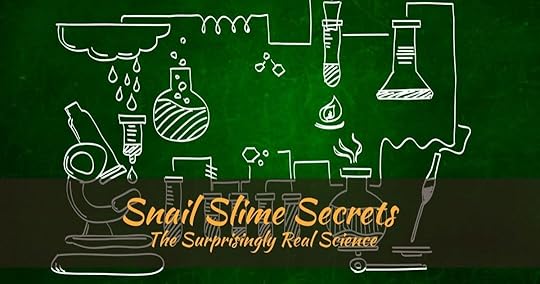Snail Slime Secrets: The Surprisingly Real Science

While writing A GHOST IN AMBER, I was set on having my heroine, Lady Diana Star, be a malacologist. A what? Someone who studies mollusks (then a-new-to-me-term). Even better, she would be fascinated by fossilized snails… especially as she possessed a necklace with a snail embedded in amber. But how to tie this to a plot? I dove down research rabbit holes. And discovered that snail mucus had been used medically as a healing agent for over 2,000 years – and is even now the basis for cutting-edge biomaterials. And it’s excellent for treating steam burns. Perfect for the 19th century and the Age of Steam.
Ancient Wisdom, Victorian CuriosityThe medicinal use of terrestrial mollusks stretches back to antiquity. Ancient Greek physicians, including Hippocrates himself, prescribed crushed snails mixed with sour milk for inflammations and burns. Roman naturalist Pliny the Elder documented numerous snail-based remedies in his encyclopedic Natural History. Throughout medieval Europe, snail preparations appeared in herbals and medical texts for treating wounds, coughs, and skin conditions. By the Victorian era, natural philosophy and the emerging field of zoology were experiencing a golden age. Amateur naturalists and professional scientists alike collected, catalogued, and experimented with creatures great and small. A scientifically-minded man like our hero, Lord Leo Wraxall, would have had access to both folk knowledge and emerging scientific journals. What was he working on?
The Snail’s Secret: A Natural Healing SerumModern molecular biology has revealed what ancient healers observed empirically: snail mucus is an extraordinarily complex biological cocktail designed for protection, adhesion, and repair.
Three Types of MucusGarden snails (Cornu aspersum, formerly Helix aspersa) produce three distinct secretions each with its own mechanical properties and molecular composition:
Adhesive mucus from the foot surface—allowing them to climb wallsLubricating pedal mucus for smooth locomotionProtective mucus that shields against environmental threats, pathogens, and UV radiationMolecular MagicResearch into Cryptomphalus aspersa (a related species) has identified the molecular mechanisms behind snail mucus’s regenerative properties:
Antioxidant enzymes that protect cells from oxidative damageGrowth factors that stimulate fibroblast proliferation and migrationGlycosaminoglycans that promote extracellular matrix assembly and tissue scaffoldingAntimicrobial peptides that prevent infectionMatrix metalloproteinase regulators that control tissue remodelingBasically, snail mucus tells your skin cells to multiply faster and move to where they’re needed. It helps new skin cells stick together properly and signals deeper tissue cells to build new connective structure. Researchers have identified over 70 different proteins in snail mucus. About one-third of these are completely unknown to science—they don’t match anything in our protein databases.
Burns and BeyondA landmark clinical study tested Helix aspersa extract on partial-thickness burns with stunning results:
Faster healingQuicker epithelialization (wound closure)Reduced painBetter outcomesThe snail extract wasn’t just effective—it was more effective than the standard medical treatment, with the added benefit of being less painful.
The Hydrogel ConnectionModern burn treatment increasingly uses hydrogels—water-swollen polymer networks that maintain a moist wound environment while allowing oxygen exchange. They cool burns, reduce pain, prevent infection, and promote faster healing without adhering to the wound bed. Here’s where Victorian science and modern medicine beautifully converge: snail mucus is nature’s hydrogel that:
Maintains moisture balanceCreates a protective barrierDelivers bioactive healing compoundsConforms to irregular wound surfacesCan be easily removed without traumaA 19th-century scientist with access to fresh snail mucus could have created an effective topical treatment that functioned much like modern hydrogel dressings—centuries before polymer chemistry made synthetic versions possible.
Snail-Inspired BiomaterialsModern researchers are taking snail science far beyond burn treatment, developing materials that sound like science fiction: Reversible superglue inspired by the dried mucus “door” snails make to seal their shells can hold an adult human with just two postage-stamp-sized pieces. Add water and you can unstick it, reposition it, and use it again Diabetic wound patches using snail compounds have healed chronic wounds in animals with a single application by calming inflammation and jump-starting tissue regeneration and blood vessel growth Tendon repair patches with one sticky side and one healing side reduced scarring by 25% in animal studies, staying in place for weeks Glowing bio-adhesive from a New Zealand freshwater snail could let surgeons actually see where they’re bonding tissue during operations, eliminating guesswork in delicate repairs.
Science Meets StoryThe snail mucus revelation opened a beautiful narrative door: my characters could use genuine science—knowledge that actually existed in folk tradition and natural philosophy—while appearing ahead of their time.  The best part? The science in A GHOST IN AMBER isn’t fantasy at all. Perfect for a ghost story where past and present collide.
The best part? The science in A GHOST IN AMBER isn’t fantasy at all. Perfect for a ghost story where past and present collide.
Consumer Products
Clinical & Scientific Studies
Comparative mucomic analysis of three functionally distinct Cornu aspersum Secretions
Molecular basis for the regenerative properties of a secretion of the mollusk Cryptomphalus aspersa
Innovative Biomaterial Applications
Glowing snail mucus: The sticky future of biomaterials
Janus, hydrogel inspired by snail slime that accelerates the care of the tendons
Reversible superglue mimics snail slime
A natural biological adhesive from snail mucus for wound repair
Hydrogel Wound Care (Content warning: contains images of treated burns)
When and How to Use Hydrogel for Wound Care: When Are They the Right Choice?
Snail Slime Secrets: The Surprisingly Real Science | A Ghost in Amber | Anne Renwick


